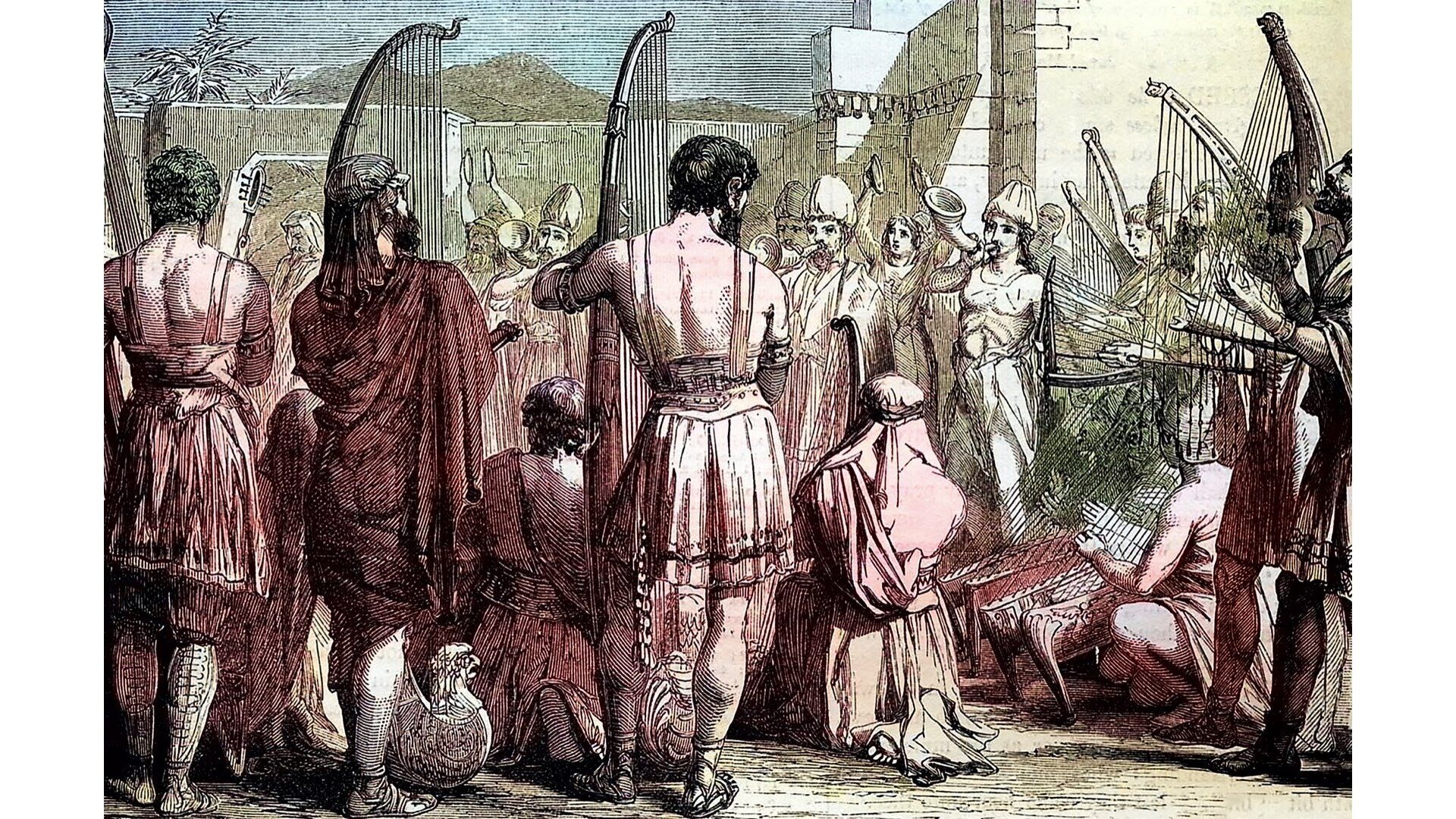Touring the Musical Instrument Museum in Phoenix, Arizona, is an epic experience. The approximately 18,500-square-meter (200,000-square-foot) facility displays and explains instruments from all over the world and from ages past to the present.
One thing struck me about every exhibit. No matter how diverse the colors, materials, shapes or sizes of the instruments were, there are still only three basic kinds of instrumental technology: Either you hit it, send air through it, or make a string vibrate. Percussion instruments have numerous varieties. In terms of sending air through an instrument, this can either be facilitated by blowing over a hole, buzzing the lips together into a mouthpiece (in the case of brass instruments), or blowing through a reed (the air either coming directly from the mouth or through an intermediary bag, as in the case of bagpipes—for which many varieties abound in several cultures). Strings can be made to vibrate by being plucked, bowed or struck in some way (e.g. pianos, dulcimers).
These are the basics of instrumental “technology,” and since the dawn of our world this potential has always existed.
It is clear from the biblical record that ancient Israel employed all sorts of instruments—each one some sort of variation on one of these three major “themes.” This variety, and the way they were used, bespeak a rich musical culture for the Hebrews who lived in “biblical” times.
The Levites, who must have believed their culture possessed a special musical insight, said these instruments were “for the songs of God” (1 Chronicles 16:42). 2 Chronicles 7:6 refers to “instruments of music of the Lord, which David the king had made, to give thanks unto the Lord ….”
Challenges in Translation
We do encounter difficulties in our study of these instruments. 2 Samuel 6:5 is a prime example. Joachim Braun considers “cypress wood” to refer to an instrument itself—to “clappers made of cypress,” since archaeology has revealed clappers: “During the monarchy … cypresses were still plentiful in Israel, and the people probably played clappers made of wood during the great cultic and paracultic festivals” (Music in Ancient Israel/Palestine).
Imagine how difficult it would be 4,000 years from now to try to uncover what our instruments were like purely based on their names. For example, even if you know our piano—which means “soft” in Italian—came from the pianoforte (named after its capability to play varying degrees of volume), it wouldn’t describe anything about its construction or what family of instruments it belonged to.
Biblical writers included little detail about the construction and sound qualities of these instruments. “Here and there an adjective, such as ‘sweet,’ ‘pleasant,’ ‘solemn’ and the like, is all we learn about their sonorities,” Alfred Sendrey wrote in Music of Ancient Israel. He shed more light on this dilemma: “The chroniclers restrict themselves mainly to mentioning the names of the instruments. But with the lapse of time even this primary knowledge was dimmed to such an extent that already the early rabbinic writers were in doubt whether some of the names referred to a stringed instrument or a wind instrument. The pictorial representations in Egyptian, Babylonian, Assyrian, and partly also in Greek and Roman antiquities, furnish us a working basis for drawing reasonable conclusions about the instruments of the ancient Hebrews. The etymology of the Hebrew names of instruments affords valuable information as to their origin, and sometimes also their sound quality.”
Sendrey, Braun and other authors look at the archaeological finds of surrounding cultures, but little exists in Israel because of the sheer annihilation of the nations in that area on at least two occasions. We will examine what does exist; using the archaeological finds of other nations can be precarious since the Israelites were known to be culturally unique in many ways. After all, they were at one time ruled by a king who directed the creation of 4,000 instruments (1 Chronicles 23:5).
Affinity for Strings
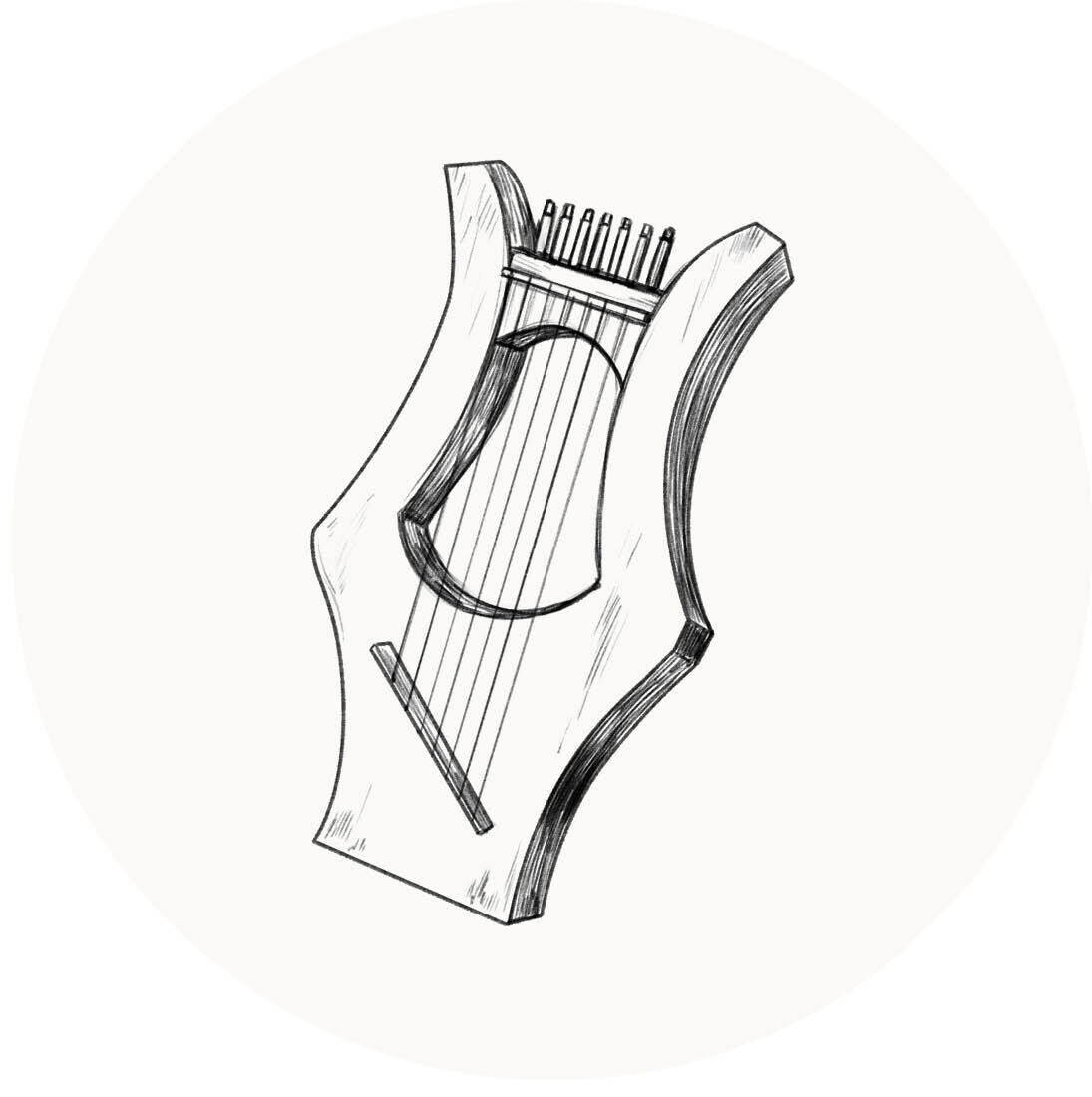
Ezekiel 33:32 likens peoples’ reactions to a watchman to one who “hath a pleasant voice, and can play well on an instrument; so they hear thy words, but they do them not.”
To “play well” is from the Hebrew nagan, meaning to play or strike strings. Stringed instruments were central to the Hebrew musical culture—partly from its most utilized instrument (the harp, or kinnor) and also from the fact that words for playing instruments and even a word for singing praises come from the roots meaning “to pluck.”
Psalm 150:4 declares: “… Praise Him with stringed instruments ….” The word for “stringed instruments” is men in Hebrew, literally meaning string, portion or, as the Gesenius’ Hebrew-Chaldee Lexicon states, “slender threads.” This word is used in only one other place: “… Out of ivory palaces stringed instruments have made thee glad” (Psalm 45:9). Just like our modern strings, they served a variety of functions and moods, from the “glad” (as in Psalm 45) to more somber, even ominous, flavors.
As for the construction of the instruments, the Bible does not give many technical details, though it mentions “all manner of instruments made of cypress-wood …” (2 Samuel 6:5). This attests to high quality. Solomon also had special wood imported for his musical instruments (1 Kings 10:11-12; 2 Chronicles 9:10-11). These arguably were the “Steinway” or “Stradivarius” instruments of their day.
Kinnor Varieties
The harp, Hebrew kinnor, is the star instrument of the Hebrew Bible. It is used 42 times in references that span many centuries. The Hebrew word is similar to the Syrian and Arabic-Persian words for “lotus,” and archaeological discoveries confirm that harp-like instruments have been made of lotus wood.
The 19th-century German historian Johann Weiss asserted that the Semites brought the harp into Egypt. Weiss also felt that the harp would not have been a tiny instrument with only a few strings. He believed that the Hebrews would not have chosen that for their national instrument if it produced weak or thin sounds.
An interesting grave mural of Egypt’s Khnumhotep ii shows a nomadic group. This image dates to 1900 b.c.e., the time of Abraham, and depicts 37 Semitic men, women and children. They have weapons and animals, and the group’s leader is called Abi-shar, “the ruler of a foreign country.”
This mural shows a portable lyre that was “held horizontally so that it could even be played comfortably while walking … while simultaneously allowing the musician to breathe more easily while singing” (Braun, op cit). Braun notes that musical activity at this time appears to be closely associated with the Chaldean or Babylonian culture of that time, from where Genesis 12 says Abraham was called.
Some hypothesize this image (since it dates to roughly the same period) could even depict Abraham’s journey into Egypt. The Jewish historian Josephus credited the patriarch for bringing arithmetic, astronomy and other types of learning “from the Chaldeans into Egypt” (Antiquities of the Jews, 1.8.2). At the very least, this inscription depicts the kind of nomadic activity occurring at the time and how music may have accompanied Abraham’s journey to Egypt. It certainly attests to the use of portable harps in Israel’s pre-nationhood culture.
Some say the kinnor had seven strings, which makes musical and mathematical sense: Philo of Alexandria viewed “[t]he seven-stringed lyre … as a reflection of the celestial harmony, and the soul itself [as] a well-tuned lyre” (Braun, op cit).
Abraham Portaleone (1542–1612), an Italian-Jewish physician, scholar and author, described the kinnor as a large harp with 47 strings. These harps, however, might have been too heavy to hang on willow trees (Psalm 137:2).
Most likely, the word kinnor implied a stringed instrument that varied in size depending on the context—much like we use the term piano today (whether spinets, uprights, or baby grands). Spanning such a range of Bible history, it is highly unlikely that it was one set design or even the same number of strings in each iteration.
Some Hebrew words translated as musical instruments simply mean “third” or “10th.” Some have used those words to assume that there were three- or 10-stringed instruments. 1 Samuel 18:6 mentions “three-stringed instruments.” Psalm 33:2 and Psalm 144:9 render the word for “10th” as “psaltery of ten strings,” and Psalm 92:4 translates the same word as “instrument of ten strings.”
The shaliysh, or the “third,” could be referring to a triangle, a triangular-shaped instrument or perhaps even a pleasing musical interval or harmony—after all, three strings would not be mathematically or acoustically practical unless it was a bowed string instrument (our modern bowed instruments usually have four strings). Many depictions of ancient bowed instruments were, in fact, three-stringed mechanisms. One Medieval image illustrated a monarch with a three-stringed instrument, supposedly depicting King David.
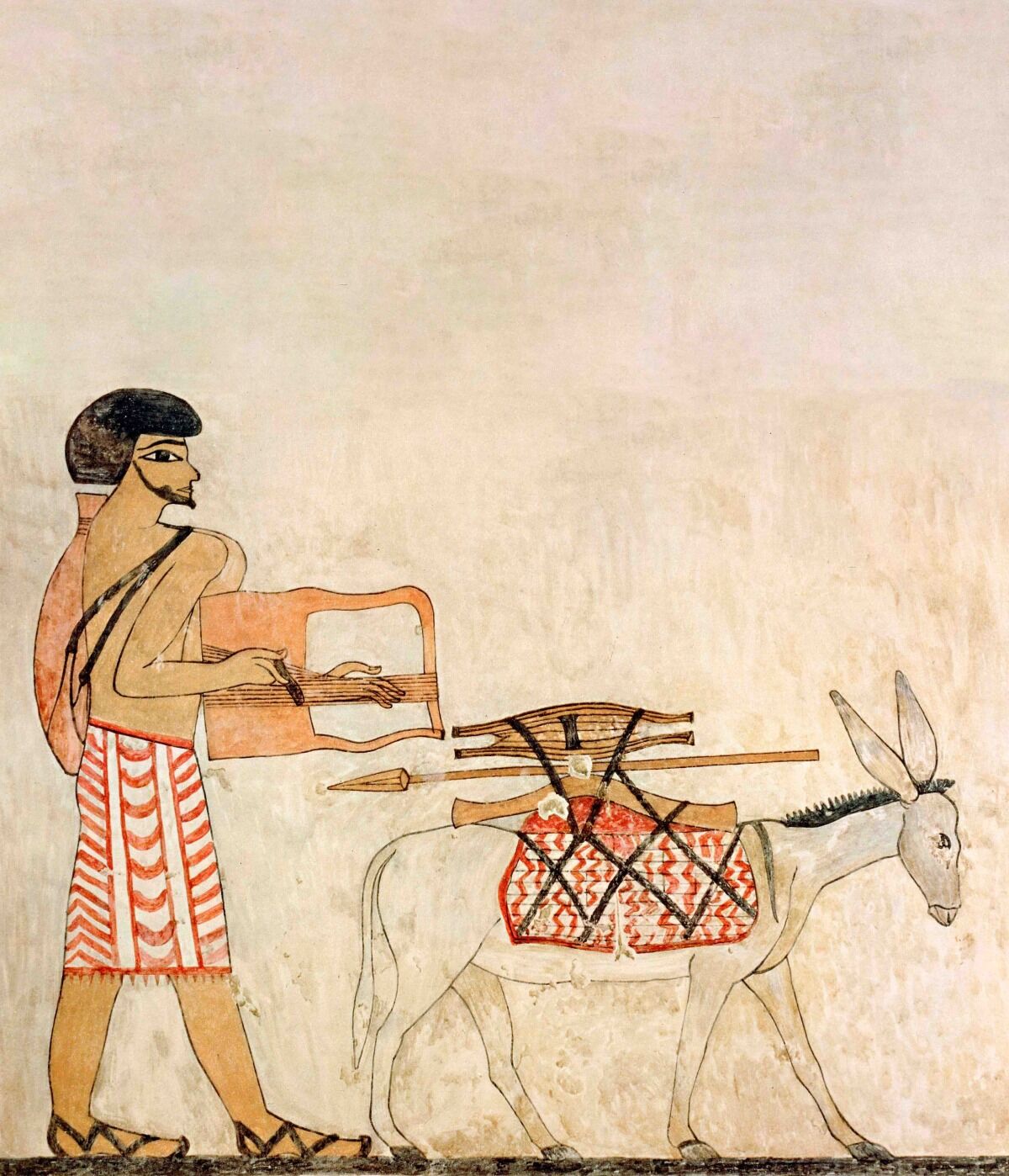
As for the 10th, the Hebrew asor may have referred to a 10-stringed instrument. Josephus referred to a 10-stringed instrument “played upon with a bow,” though most translations of Josephus say “struck with a plectrum.”
Did the Hebrews employ a bowed string instrument? Certainly the “plectrum” pictured in various ancient drawings is too big to be a plucking device. Bowed instruments did not originate in modern history with the Italians but were known in antiquity, originating in Persia and Arabia, according to musicologist Carl Engel. Perhaps it is no coincidence that the Hindu word for this kind of instrument (from one of the originating cultures of the instrument) is kinnere, similar to the Hebrew kinnor.
Joseph Walker discussed the Celtic cionar cruit as an instrument of “10 strings … played on with a bow or plectrum.” He wrote, “As no drawing of this instrument has reached us, we can only suppose it resembled the hashur [or asor] of the Hebrews, of which such frequent mention is made in the Psalms, by the name of the 10-stringed instrument” (Historical Memoirs of the Irish Bards). Josephus called this instrument the kinyra, from which, perhaps, “cionar cruit” is derived.
Another interesting etymological connection is that the name for a certain bowed string instrument is the geige. The Swedes use the word giga to denote a Jew’s harp, and Engel wonders if this word is the root of the English word jig.
Stringed instruments in ancient Israel probably had a similar amount of variety as they have today. Ample evidence exists of plucked instruments, like our harps; some evidence suggests there may have been bowed string instruments anciently as well, like our fiddles; and archaeology confirms Israel had plucked string instruments held by a neck, much like our lutes or guitars.
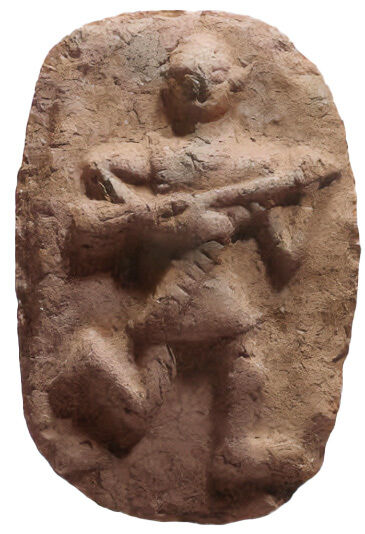
A terra-cotta relief was found at Tel Dan in Israel’s north, where the tribe of Dan settled early in the judges period. This artifact, known as the “Dan dancer,” dates back to the 14th century b.c.e. Braun writes that “everything suggests that this figure is a folk musician”: The raised leg indicates a dancer, and the “expressionless face might represent a mask worn during performance” (op cit). The relief was found on a paving stone in a courtyard where such performances took place.
Braun calls this find “one of the most remarkable representations of lute players we have” because none of the characteristics of this image share any parallel in this time and place: “[T]he combination of instrumental music, dance and theater in the Dan figurine suggests that a highly professional group of entertainers had developed whose activity was quite separate from the cult.” In other words, this bespeaks a secular musical culture in addition to the well-documented religious one found in the Bible.
Nebel—String or Wind?
Despite the dearth of archaeological evidence, historians insist that the nebel is some kind of stringed instrument. Braun admits that the “historian has no real archaeological evidence of harps for any subsequent interpretation of the nebel.” So what is it? Is it even a stringed instrument?

Bible translations vary wildly in how they render this word, even within the same translation. If only they had left it untranslated and let us see the definition for what it is: Nebel literally means “skin-bag,” “skin-bottle,” “inflate,” “bulge” or something that collapses when empty. This may help support the idea that the nebel was an ancient form of bagpipe technology where air is sent into a bag and then squeezed through a reeded chanter. The Irish pipes are an example where air is not provided from the mouth, allowing the player to sing while playing the instrument—as some verses imply of the nebel.
Isaiah discussed their “noise” (Isaiah 14:11). Braun says this verse indicates the instrument was capable of a powerful drone.
Scholars say that it was shaped like a leather bag but that it literally was not, refusing any cultural connection between Jews and Celts (even though bagpipe-like instruments are present in many other cultures). Bagpipe enthusiasts point to the Hittite slab from 1000 b.c.e. found in Eyuk, Turkey, as the most ancient depiction of this instrument.
Musicologist and composer Abraham Idelsohn (1882–1938) believed nebel al alamot (as the Hebrew reads in 1 Chronicles 15:20) to be a bagpipe. He asserted that the nebel was the bag on which the pipes were fastened and the alamot was the double flute. The term alamot can mean “soprano” or “falsetto,” which could describe the high-pitched sound of the instrument. The Mishnah refers to the bagpipe, using a more modern Hebrew term: chamat chalalim—literally, stomach pipes, the animal part from which ancient bagpipes were constructed.
Types of Trumpets
Referenced more than any other, the shofar is the only instrument of ancient Israel that has survived the millenniums in its original form. No mystery surrounds its construction, sound or significance. It was used for a range of purposes, from the frightening to the festive. Of its 72 references, the majority of them refer to the alarm of war, though the shofar was more versatile than that. It was also used as a general gathering device, as a precursor to major announcements, as part of coronations, and several times in the context of praise, joy or other sacred celebrations. Chroniclers used the word shofar to describe God’s voice. In Joshua 6, God commanded seven priests to blow seven trumpets (shofar) of rams’ horns. The term shofar describes the sounds of the ram’s horn—the Hebrew yobel, from where we get our English word jubilee. The shofar was even blown on the Day of Atonement to announce the jubilee.

The ram’s horn contained rich meaning to the Hebrews: Many still connect the horn’s use to Abraham finding the ram to sacrifice in place of his son (Genesis 22:13).
Psalm 98:6 gives a joyous reference to the shofar and introduces us to another Hebrew trumpet: “With trumpets and sound of the horn Shout ye before the King, the Lord.” Here the translators use the English “horn” for the shofar, probably to distinguish it in the English from the other “trumpets,” the silver ones described in Numbers 10 (Hebrew chatsoserah). These trumpets are referred to 29 times and are the only instruments for which the Bible gives fairly detailed information about their construction and material. It was made of one whole piece of silver and was for “the calling of the congregation, and for causing the camps to set forward” (verse 2). It would have been long and straight, with a bell at the end. Josephus corroborated this, as does the archaeological record of similar trumpets in neighboring cultures. The clarion and resonant tone of the silver metal would have given this instrument a sound both grand and piercing.
These trumpets, too, had both joyous and sobering functions (verses 4-9)—as an alarm of war, as an organization device and to mark the new moons. Rabbinic sources indicate they were also blown to announce the Sabbath.
Numbers 31:6 shows them functioning in warfare. In the Dead Sea Scrolls, the War Scroll of Qumran contains a document called “The Rule of Battle,” which shows a similar usage. Sendrey commented: “This Rule of Battle intimates that the priests and Levites have been assigned quite an important role in the battle, namely to direct the operations of the troops in the midst of the combatants. In giving appropriate signals with trumpet and shofar blasts, they marked the different phases of the engagement. Priests and Levites as strategists—a peculiar role, though not entirely novel. It may be considered as a mere elaboration, or even as a more detailed description, of the older practice, as found especially in 2 Chronicles 13:12, 14, but partly also in … Joshua 6:3 and Judges 7:8, 16, 18-20, 22 [referencing Joshua’s and Gideon’s use of the shofar]. Looking into the purely musical spect [sic] of this detailed ‘order of battle,’ we realize that the priest-strategists had at their disposal seven different kinds of blasts for the assembly, the advance, the attack, the ambush, the pursuit, the reassembly and the recall. Such blasts must have had some conspicuous rhythmic or other characteristics, without which their specific purposes could not have been recognized by the fighting men.”
Other Winds and Drums
The Hebrews also employed other wind instruments in their music. The Bible mentions the chalil (translated “pipe”), the root of which means to “hollow out” or “pierce.”
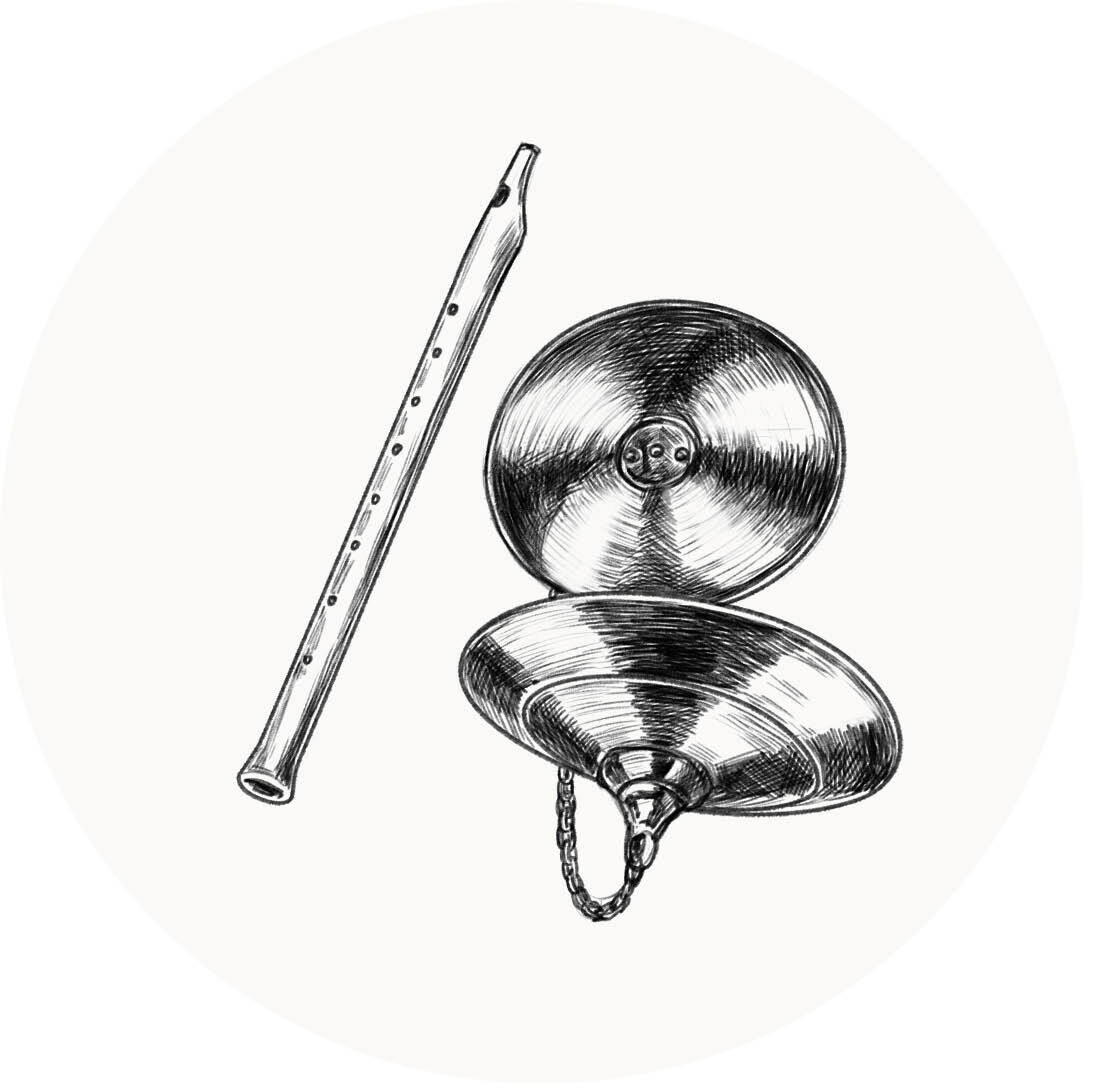
The Septuagint and the Vulgate render it as a kind of reed instrument like a clarinet or oboe. Some suggest a flute. The only wind instrument that archaeologists are sure existed in Israel’s Iron Age is the double pipe, like a double flute. Today, we are quite familiar with the sounds of the clarinet in Jewish music, and perhaps that sound had its roots in this biblical instrument. Whatever the instrument, it was quite common in Israel at the time of Solomon’s coronation, when “the people piped with pipes, and rejoiced with great joy, so that the earth rent with the sound of them” (1 Kings 1:40).
This description may confirm Sendrey’s assertion that the Hebrew terms for pipes referred more to families of instruments rather than specific, individual instruments.
The same may be true of ugab, another kind of “pipe.” Musicologist Curt Sachs believed it was a long flute. Whatever the case, the references to this instrument are only found in the earlier writings (Genesis and Job), so it likely became extinct or was replaced by the chalil (with its first reference in Samuel’s day).
In addition to the tof or “timbrel,” of Psalm 81:3 for example, the Hebrews had other percussion instruments. One commonly mentioned in musical references is the cymbals: Metseleth is used 13 times and always in a particular Hebrew plural form signifying two of an item; Gesenius’ Lexicon notes that it is “dual” or as “a pair of cymbals.” It comes from a root meaning” tingle” or “quiver.” 1 Chronicles 15:19 tells us that they were made of nechosheth—a word used interchangeably for copper or bronze. This instrument is not introduced in the Hebrew text until David finally brought the ark of the covenant back to Jerusalem.
The other word translated “cymbal” is tselatsel, translated “cymbal” three times and “locust” once. The word means “whirring” or “buzzing,” which is probably why it works as “locust,” though it is not the common Hebrew word for locust. As an instrument, it probably served a different function than the metseleth. Psalm 150:5, which contains two of the three tselatsel references, states that they were “loud-sounding” and “clanging”—the latter being the Hebrew teruwah, which is usually used for a loud trumpet blast. Tselatsel was used in David’s first attempt to bring the ark back to Jerusalem. Along with that is another instrument, mentioned only once in the Old Testament. The “sistra” of 2 Samuel 6:5 is certainly the ancient instrument of the same name. The Hebrew word means “rattle,” and its root means “shake,” “tremble” or even “sift,” which is indicative of how this instrument sounded.
The only remaining Hebrew instrument to define is teqowa (Ezekiel 7:14), translated as “horn”: “They have blown the horn, and have made all ready, but none goeth to the battle; for My wrath is upon all the multitude thereof.” Neither a shofar nor a chatsoserah, this word is only used here. Its root is taqa, which is used for “blown” in this verse; so they, more literally, “blow the blowing implement … but none goeth to battle.”
A Babylonian Contrast
The one other substantial mention of instruments in the biblical record is in Daniel 3. Though not properly instruments of the Hebrews, they are worth considering in this context.
The scene is the golden image Nebuchadnezzar erected that was to be worshiped “at what time ye hear the sound of the horn, pipe, harp, trigon, psaltery, bagpipe, and all kinds of music …” (Daniel 3:5). Verse 7 says the people did this when they heard this grouping of instruments, and the list is repeated.
The accusers of the three Jews who would not obey this reminded the king of his decree, and repeated the instrument list verbatim (verse 10). Verse 15 quotes Nebuchadnezzar to the three Jews, and he again lists the instruments.
Braun says “these enigmatic musical instruments—which the author introduces four times in his work almost like a threatening ostinato—evoke for the Jewish readers the presence of an alien, even hostile musical culture” (ibid). These instrument names are found only in Daniel 3, partly because this is the section of Daniel written in Aramaic—the lingua franca of the Near East at the time. Some words correspond to the Hebrew, but it poses the question: How different was the music of Babylon? Psalm 137 shows their interest in hearing Zion’s music from their Jewish captors. Nebuchadnezzar’s court was interested in learning from the Jewish captives (Daniel 1:3-4, 15-16, 18-20). The Aramaic words for these six instruments are: 1) the qarna, similar to the Hebrew qeren, and likely a metal or clay trumpet, as cylindrical instruments like these were known to be used in Babylon, and were about 70 to 90 centimeters in length; 2) the mashrotquita, some sort of wind instrument, possibly one with a reed; 3) the kiyatharos is something like a lyre or lute, and the word is where the English get the word guitar and the Arabs get their kuitra; 4) the sabbeka, likely another kind of stringed instrument that is perhaps more like the harp; 5) the pesanterin, which may have been a dulcimer-like instrument where the strings were struck; 6) the sumponeya is translated here as the “bagpipe,” though the similarity to the Greek symphonia may mean this is when all the instruments were played together—after each had played its motif in the order that the decree said they would. Curt Sachs rendered it: “As soon as you hear the sound of the horn, the pipes, the lyre, the horizontal and vertical harp, the full consort and all kinds of instruments …” (Rise of Music in the Ancient World).
Humanity’s use of the varying forms of instrumental technology throughout history is evident in both the archaeological and biblical records. The details confirmed in the Hebrew Bible show Israel indeed stood out for its exemplary use of these instruments.
